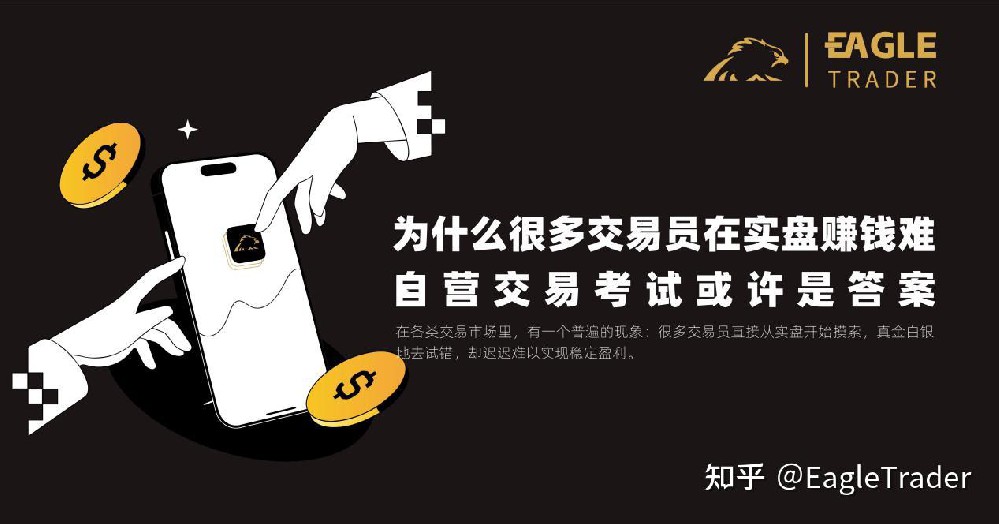Why are many traders making money in real-time? The self-operated trading exam may be the answer
- 2025年9月29日
- Posted by: Eagletrader
- Category: News
In various trading markets, there is a common phenomenon: many traders start to explore from the real market, and try and make mistakes with real money, but it has been difficult to achieve stable profits.
But this is not because they are not smart enough, nor because their skills are completely out of line, but because real-time trading itself is a practice that requires long-term endurance and extremely high self-discipline.

The “invisible threshold” of real market
Most traders have the same idea in their minds when entering the market: earn real returns through their own judgment. But the market will soon give the first lesson—the importance of emotion and risk management.
In real trading, every order means the real rise and fall of funds. Fear makes people stop losses too early, and greed makes people increase their positions too heavily; once they encounter violent fluctuations, the imbalance in their mentality is often more fatal than the market itself.
Even if you have certain skills, you will shrink your hands because you are “afraid of losing money”, or you may have a heavy position due to “doubling”, causing your account to retreat.
In addition to the psychological level, fund management is also an insurmountable obstacle.
In order to make up for the losses, many traders will unconsciously expand their positions. Once the direction is wrong, the accumulation of months or even years may evaporate overnight.
The transaction costs of the real market – spreads, slippages, and handling fees – are silent “invisible consumption” in long-term operations, further compressing the already fragile profit space.
These invisible pressures have caused many traders to try and make mistakes and pay tuition fees repeatedly in real trading. Some have survived the long pullback, while others have stopped in the first round of liquidation.
Is there a safer path to growth?
In this context, a question has gradually been raised by more people:
“Is there a way to hone trading capabilities in an environment as close as possible to the real market without having to bear the risks of own funds?”
In the past, traders often could only switch back and forth between simulated trading and real trading.
But the simulated market lacks pressure and it is difficult to exercise real risk control and execution; and the direct real market means high capital costs and psychological costs.
There has been a long time since there is a truly effective “transition zone”.
Owned trading exam is becoming the answer
In recent years, the EagleTrader self-operated trading exam has provided traders with a new growthpath.
It is based on the real market environment and the risk control standards of professional trading teams as the framework to build an assessment mechanism that does not have principal pressure but must be as rigorous as real money.
Traders are evaluated in the simulated fund accounts provided by the platform to train their mentality and strategies. Once their results meet the standards, they can directly enter the profit sharing stage, and they can obtain up to 90% of the account profit sharing, and even get professional positions opportunities.
For traders who want to accumulate practical experience but do not want to take huge capital risks, this is a steadily leading to professionalization.
Different growth rhythms
Real trading
In traditional real-time trading, traders must invest their own funds, and each loss directly affects personal assets. This means that even a small mistake may bring long-term financial pressure.
At the same time, all costs of real-time trading – including spreads, slippages, and handling fees – are borne by the trader alone. On the psychological level, the fear and greed caused by the real fluctuations of funds will amplify emotions and increase the difficulty of execution.
Owned Trading Examination
In the EagleTrader self-operated trading exam, traders operate simulated funds provided by the platform, but the trading environment is still close to the real market, and the risk control standards for the assessment are consistent with the professional trading team.
Losses will not directly erode personal funds, but the exam will also require candidates to strictly manage positions and drawdowns as if they were facing real money.
And once the assessment is passed, traders can not only enter the profit sharing stage, but also obtain up to 90% of the profit sharing of the account profit, but also have the opportunity to enter a professional trading team to achieve a complete promotion from assessment to profit sharing and then to career development.
It can be said that the real market is more like stepping into the battlefield directly, and you need to pay for success and failure; while the self-operated trading exam provides a “training first and then battlefield” model – tempering trading capabilities without financial pressure, making the pace of growth more controllable and safer.
For traders, the core of trading is never just an opportunity to make huge profits, but the ability to survive in risks for a long time.
EagleTrader self-operated trading exam is to let you learn how to control positions in the real market, maintain the bottom line in the risk, and accumulate advantages in the rules.
This may be a smarter path for traders who are still exploring the market.
